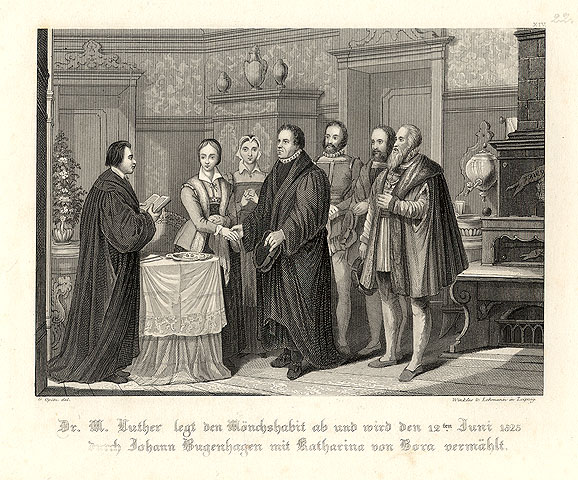In part 2 of our series on Katherine von Bora, we learned that she and 11 other nuns escaped from the cloister with the help of a city councilor named Leonard Koppe. When they got to the town where they were going, they had to marry quickly or try to work on their own. Luther helped them all to find respectable jobs or husbands, all except Katherine. She befriended a man whom she wished to marry, but his family would not accept an ex-nun. She was heartbroken. Luther tried to match her with someone else; she refused that man.
Luther didn’t seem to be in a big hurry to marry. He was 42 when he started to consider Katherine as a bride. Finally, in 1525 he decided to please his parents and irritate the pope and the devils by “getting married with the last ex-nun available in town.” Some people rejoiced in the marriage; others were scandalized. This was not just because it was Luther, but because clergy were only just beginning to get married.
It took some getting used to for people in the early 16th century.
They were married on June 13, 1525. There was only a small group attending the ceremony. Two weeks later they had a larger feast with many more guests.
Katherine modeled the wife of a pastor exceedingly well. She mothered six children of her own, and cared for six or seven nieces and nephews, and four orphans, along with many others who came under her roof.
Her home was a Pastor’s and professor’s home, and she set the standard for reformer’s wives. The parsonage was a place where the evangelical faith would be fostered. Her convent training enabled her to help Luther run a boarding school for theology students, a hostel for visitors, theological conversations centered around her husband, occasionally turning her house into a hospital, receiving refugees, providing meals and beds for all, and finding money to cover all the costs. She also made tasty beer.
Though we know that Luther appreciated all that she did, affectionately calling her “doctor, preacher, and lord,” Katherine did not exercise authority as a theologian or preacher outside of their home. Luther did not encourage it.
Katherine was able to use her gifts of intelligence and organization by managing the “Black Cloister,” an abandoned monastery that she turned into a seminary. Here she “ruled” a “congregation” that filled all 40 rooms and she hosted the meals daily for the residents and hosted banquets for as many as 120 people. This was a popular gathering place, and would become the model for the parsonages in the future which would become places for people to come together to discuss theology, entertainment, and spiritual growth.
She managed to finance all of this by raising vegetables and fruit. She raised animals, fished, baked bread, and brewed beer. She increased their wealth by buying land. As an aristocrat, she understand the value of land and talked Luther into buying two farms and two orchards.
She still had to live by the rules of the times. She showed respect to her husband, by addressing him formally, subjecting herself to his authority, practical, legal, and spiritual. Luther considered her an equal partner “in Christ” but not as an equal partner in his preaching ministry.
However, she participated in “table talks.” She knew enough Latin and Scripture to join in, much to the annoyance of some at the table who thought her behavior inappropriate for a women. Apparently though, Luther made no effort to stop her. Martin called her “My Lord Katie”.
When he died suddenly in 1546, she was extremely sorrowful. She also found herself surrounded with many difficulties. There were no church widow’s pensions then, and she had to make do, supporting their children on what Luther had left her. She faced her situation squarely on as she had always done in life. Many other difficulties arrived; she soon found herself a refugee as armies turned her farm into a battlefield. There were also recurrences of the plague. As she was trying to escape from plague-ridden Wittenberg, she fell from a wagon. She died as a result of injuries from this accident in December of 1552.
Katherine contributed much to her husband’s ministry. She certainly helped with his understanding of marriage, love, gender roles, and family life. By doing this, she contributed much to the spread of the Gospel. She modeled the ideal Christian woman. By being a Proverbs 31 woman, her husband’s ministry was expanded further. Because she could manage everything on the home front, including the Black Cloister, Luther was able to be away on long journeys, preaching and teaching, knowing that he could come home to a restful, well-ordered, spiritually invigorating home.
Katherine loved Christ. She lived her life to the fullest. She showed us how to live the Christian life in our marriages, families, and communities. It takes a lot of courage to face the daily mundane tasks of cooking, cleaning, and mending. As we contemplate on the life of Katherine von Bora Luther, I hope it will give us renewed strength to find joy in whatever calling God has given us.

